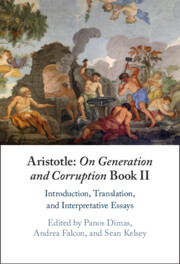 Aristotle: On Generation and Corruption Book II
Aristotle: On Generation and Corruption Book II Book contents
- Aristotle: On Generation and Corruption Book II
- Aristotle: On Generation and Corruption Book II
- Copyright page
- Contents
- Figures
- Tables
- Notes on Contributors
- Preface
- Abbreviations
- Part I Introduction and Interpretative Essays
- 1 On Generation and Corruption II
- 2 On Generation and Corruption II 1
- 3 On Generation and Corruption II 2
- 4 On Generation and Corruption II 3
- 5 On Generation and Corruption II 4
- 6 On Generation and Corruption II 5
- 7 On Generation and Corruption II 6
- 8 On Generation and Corruption II 7
- 9 On Generation and Corruption II 8
- 10 On Generation and Corruption II 9
- 11 On Generation and Corruption II 10
- 12 On Generation and Corruption II 11
- Part II Translation
- References
- Subject Index
- Index of Passages
11 - On Generation and Corruption II 10
from Part I - Introduction and Interpretative Essays
Published online by Cambridge University Press: 10 November 2022
- Aristotle: On Generation and Corruption Book II
- Aristotle: On Generation and Corruption Book II
- Copyright page
- Contents
- Figures
- Tables
- Notes on Contributors
- Preface
- Abbreviations
- Part I Introduction and Interpretative Essays
- 1 On Generation and Corruption II
- 2 On Generation and Corruption II 1
- 3 On Generation and Corruption II 2
- 4 On Generation and Corruption II 3
- 5 On Generation and Corruption II 4
- 6 On Generation and Corruption II 5
- 7 On Generation and Corruption II 6
- 8 On Generation and Corruption II 7
- 9 On Generation and Corruption II 8
- 10 On Generation and Corruption II 9
- 11 On Generation and Corruption II 10
- 12 On Generation and Corruption II 11
- Part II Translation
- References
- Subject Index
- Index of Passages
Summary
This essay explores the role that GC II 10 plays in the context of the treatise as a whole. It argues that while the rest of the treatise, up to and including GC II 9, explains generation and perishing by means of material and formal causes, GC II 10 provides the efficient and final causes, and thus brings the project announced at the outset of GC to completion. The essay analyses the arguments for the efficient cause of generation and corruption (identified with the sun’s annual course along the ecliptic) and its final cause (identified with a universal desire for the highest kind of being). For Aristotle, the best approximation to the being of imperishable substance which the sublunary sphere permits, given the nature of its constituents, is perpetual reproduction (for living things) and an endless cycle of reciprocal change (for elements). Finally, the essay illustrates how Aristotle’s fourfold scheme of causal explanations practically applies to generation and perishing in view of what Aristotle claims elsewhere about the unmoved mover and the gradation of being.
- Type
- Chapter
- Information
- Aristotle: On Generation and Corruption Book IIIntroduction, Translation, and Interpretative Essays, pp. 216 - 242Publisher: Cambridge University PressPrint publication year: 2022


